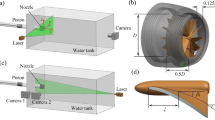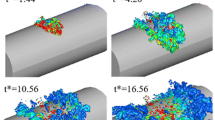Abstract
The figures show the 3D flow pattern of a circular jet with different swirling intensity. Reynolds number is approximately 4300 computed based on the nozzle diameter (d), jet velocity (U), and air fluid property at 1 atm and 300 K. The overall computational domain is set to be 4 × 4 × 12 d in spanwise, height, and streamwise direction. The governing equations are the fully compressible Navier–Stokes equations, firstly differenced by eighth-order explicit scheme and then advanced temporarily by using the fourth-order explicit Runge–Kutta method. 3D characteristics non-reflecting boundary condition including transverse source contribution is imposed on all other boundaries except the inflow boundary handled by assigning fixed profiles of temperature and velocity. To ensure the simulation resolution, here over 16 million grids are employed in sum, combined with a handful of grids located at buffer zones of outflow boundaries. To correctly represent the vortex in the flow field, velocity gradient tensor invariant Q is used here. And ψ refers to the swirling intensity defined as the ratio of tangential momentum to axis momentum. As shown in velocity profile, the flow pattern of the jet changes from a close mode to a totally open mode as ψ increases from 0.4 to 1.5. Accordingly, the recirculation zone gradually moves upstream and backflow velocity is enlarged as well. It is inteseting to found that the obvious drops of the momentums in two shown directions always occur at the same position downstream, no matter how large the ψ value is. Therefore, a momentum compensatory mechanism is expected to exist in the vortex-abundant zone. With the increase of ψ value, the increased strain rate in tangential direction can induce vortex more quickly, intensifying the entrainment and velocity-attenuation, which can be observed in Q value profile.
Graphical Abstract


Similar content being viewed by others
Acknowledgments
Supported by National Natural Science Foundation (50806066) and National Science Foundation for Distinguished Young Scholars (50525620).
Author information
Authors and Affiliations
Corresponding author
Rights and permissions
About this article
Cite this article
Zhou, Z., Lv, Y., He, P. et al. DNS study of swirling intensity effect on flow pattern of a circular jet. J Vis 13, 3–4 (2010). https://doi.org/10.1007/s12650-009-0003-8
Received:
Revised:
Accepted:
Published:
Issue Date:
DOI: https://doi.org/10.1007/s12650-009-0003-8




